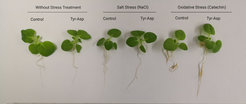Dipetides to the rescue
How small molecules help plants cope with stress
A team of scientists led by Dr. Aleksandra Skirycz, until recently a group leader at the Max Planck Institute of Molecular Plant Physiology, now a professor at the Boyce Thompson Institute (BTI) in the USA, has investigated and described in a recent study (Moreno et al., 2021, EMBO Journal) a novel regulatory small molecule that improves plant tolerance to environmental stress.

The seedlings were photographed after 7 days of oxidative stress treatment. You may find that those seedlings with Tyr-Asp that have been subjected to stress treatment have grown better than those without Tyr-Asp.
Stress in plants and their consequences
Related to their sessile nature plants are exposed to multiple environmental stresses. The source of the stress can be biotic such as microbes and insects. The source of stress can be also abiotic, for instance high and low temperatures (e.g., cold and warm environments), drought, light intensity, nutrient deficiencies, or salinized soils. In plants, stress leads to impaired growth and affects reproductive ability. In agriculture, stress causes crop yield losses and quality reductions. With increasing climate change, the influence of abiotic stress factors on plants will become more severe. Therefore, it is important to investigate and understand how plants respond to stress and how stress-related negative effects on plants can be minimized or prevented.
A common consequence of stress, whether it is biotic or abiotic, is the accumulation of reactive oxygen species (ROS). ROS radicals react with other molecules in the cells including membranes, nucleic acids and proteins and by doing so impair their function and cause considerable, and often irreversible damage. Living organisms developed numerous mechanisms to counteract ROS. Plants, for instance, accumulate a variety of compounds such as carotenoids and flavonoids that scavenge and in that was “disarm” ROS. A different small-molecule compounds that is essential for maintaining healthy levels of ROS in both plants and animals is a cofactor nicotinamide adenine dinucleotide phosphate (NADPH). Strategies that boost NADPH levels improve stress resistance and extend health- and lifespan.
Novel Mechanism in response to different stresses
Prof. Aleksandra Skirycz and her team have now succeeded in describing a novel mechanism, by which plants stimulate NADPH production in response to the different stresses. This mechanism entails yet another small-molecule compound, a dipeptide Tyr-Asp. Tyr-Asp works by modulating plant carbon metabolism, in a way that glucose, a universal building block, is shifted towards production of NADPH. Specifically, Tyr-Asp interferes with glucose metabolism by inhibiting a key glycolytic enzyme, glyceraldehyde-3-phosphate dehydrogenase (GAPC), thereby redirecting glucose toward the pentose phosphate pathway (PPP) and NADPH synthesis. Consistent with the molecular data, Tyr-Asp improved plant resistance toward oxidative and salt stresses.
"The small molecule we were able to identify is the dipeptide Tyr-Asp, which acts as a metabolic regulator that succeeds in increasing the NADPH/NADPH+ ratio by diverting the glycolytic flux, thereby improving the stress resistance of plants", Dr. Skirycz describes her research findings. Dipeptides are products of protein degradation, composed of two amino-acids linked by a peptide bond. However, the different dipeptides have been long-known for their health-promoting activities in animals, their mode of action remained anecdotal. “Our work laid the foundation for understanding the evolutionary conservation of dipeptides’ role in regulating metabolism and their potential to improve plant and animal health” explain Dr. Aleksandra Skirycz and Dr. Juan C. Moreno, the first author of the study.
URS
